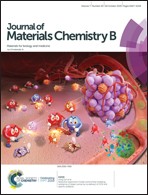Coral-shaped Au nanostructures for selective apoptosis induction during photothermal therapy†
Abstract
Apoptosis and necrosis are major cell death pathways that are induced by plasmonic nanoparticle (NP)-mediated photothermal therapy (PPTT). Apoptosis is commonly regarded as a ‘cleaner’ method of killing cells than necrosis because apoptotic cells maintain plasma membrane integrity, which prevents inflammation caused by the leakage of cytoplasmic contents. Here we report the use of PPTT employing coral-shaped Au nanostructures (Au NCs) to specifically induce apoptosis in human breast cancer MCF-7 cells. Au NCs have high efficacy in photothermal conversion owing to their strong adsorption in the near-infrared (NIR) region and high surface-to-volume ratio. The in vitro experiments showed that laser irradiation with low power density (0.5 W cm−2) for 15 min selectively induced apoptosis, which is mediated by the activation of nuclear encoded proteins Bak and suppression of Bcl-2 protein. Moreover, the use of Au NCs as heaters can effectively ablate MCF-7 xenograft tumors and prevent the return of cancer. The in vivo apoptotic pathway of MCF-7 cells was further confirmed to be selectively induced via immunohistochemistry analysis. These results offer a feasible protocol to selectively induce apoptotic cell death, which benefits the efficacy of PPTT, to promote the clinical use of PPTT.



 Please wait while we load your content...
Please wait while we load your content...